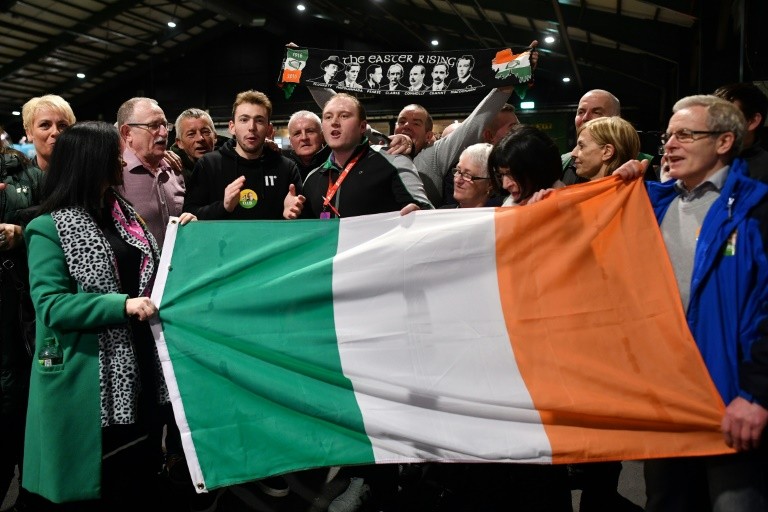Sinn Fein on Tuesday became Ireland’s second largest parliamentary party after winning the popular vote in a weekend election — shattering the political landscape and thrusting the one-time fringe party with historic links to paramilitaries into a likely role in the next government.
With counting completed in the early hours of Tuesday Sinn Fein had taken 37 of the 160 seats in the next Dail — Ireland’s lower house of parliament — after a 62.9 per cent turnout in Saturday’s election.
Centre-right party Fianna Fail were only one ahead on 38 whilst Prime Minister Leo Varadkar’s Fine Gael party took 35, a result likely to topple the premier from office.
If a new government is to be formed when the Dail sits on 20 February it must contain multiple parties.
Negotiations have already begun, with Sinn Fein arguing for a central role in power after winning 24.5 percent of first preferences in Ireland’s single transferable vote system — the largest of any party.
– End of duopoly –
Saturday’s ballot has broken the stranglehold of two-party politics in Ireland by introducing a new contender in the mainstream — the nationalist Sinn Fein party once shunned because of its links to IRA paramilitaries.
Former leader Gerry Adams and other party representatives were even banned from the airwaves in the UK as violence raged over British rule in Northern Ireland over three decades to 1998.
 AFP / Ben STANSALLIrish republican Sinn Fein party leader Mary Lou McDonald says the two mainstream parties are in a ‘state of denial’
AFP / Ben STANSALLIrish republican Sinn Fein party leader Mary Lou McDonald says the two mainstream parties are in a ‘state of denial’But with two decades of peace and a new leader under Mary Lou McDonald, Sinn Fein’s left-wing policies on tackling crises in housing and health found favour with voters.
McDonald said the two main parties — Fine Gael and Fianna Fail — were “in a state of denial” and had not listened to the voice of the people.
On a walkabout in Dublin on Monday she said she had begun talks with smaller left-wing parties to try to “test” whether it was possible to form a government without the two centre-right parties.
Read Also: Africa: Washington Uneasy Of Intense Push By Russia
“I may well be the next taoiseach (prime minister),” she said before chatting to supporters and market traders.
“Sinn Fein won the election, we won the popular vote… I’m very clear that people who came out and voted for Sinn Fein have voted for Sinn Fein to be in government,” she added.
 AFP/File / Bryan MEADEPrime Minister Leo Varadkar has been seen as the face of a new, more progressive Ireland
AFP/File / Bryan MEADEPrime Minister Leo Varadkar has been seen as the face of a new, more progressive IrelandPrime Minister and Fine Gael leader Leo Varadkar acknowledged the shift to “a three-party system” on Sunday and said talks between the parties could be protracted and difficult.
The Fianna Fail party took 22.2 percent of the popular vote and Fine Gael 20.9 percent.
“The Irish political system has to react to it and probably accept that Sinn Fein will be part of the next government,” Eoin O’Malley, associate professor at Dublin City University, told AFP.
– Young appeal –
Tuesday’s result was all the more striking because Sinn Fein ran just 42 candidates.
Analysts suggest the party may have been taken by surprise by its surge in popularity, and would likely be the largest party if it had put forward a larger slate.
Fine Gael and Fianna Fail have both ruled out any deal with Sinn Fein because of its past associations under Adams, who has long denied allegations he had a leadership role in the IRA.
“The Troubles” saw the IRA wage a campaign against unionist counterparts and British security forces over UK-rule in Northern Ireland that saw more than 3,000 killed on all sides.
 AFP/File / PAUL FAITHBallots in all 39 of Ireland’s constituencies were counted on Sunday
AFP/File / PAUL FAITHBallots in all 39 of Ireland’s constituencies were counted on SundayMcDonald’s policies on tackling wealth inequality and housing shortages appear to have appealed to younger voters in the EU member state’s 3.3 million-strong electorate.
Some 32 percent of voters aged 18-24 and 25-34 backed the party, according to an exit poll on Saturday.
Dublin coffee shop manager Darren Hart said it was time for another party to try after decades of two-party dominance.
“Whether they have a troubled past as a party or not, you know they deserve a shot, same as everybody else, so why not?” he said.
In a sign of the sea-change in Irish politics, Varadkar himself was beaten to the first seat in his constituency by a Sinn Fein candidate on Sunday.
He took the second of four seats but it was a sharp symbolic blow on a long night for the premier, who was facing the electorate for the first time as prime minister.
Varadkar — young, openly gay and mixed-race — has been seen as the face of a new, more progressive Ireland after referendums overturning strict abortion laws and same-sex marriage.
AFP

